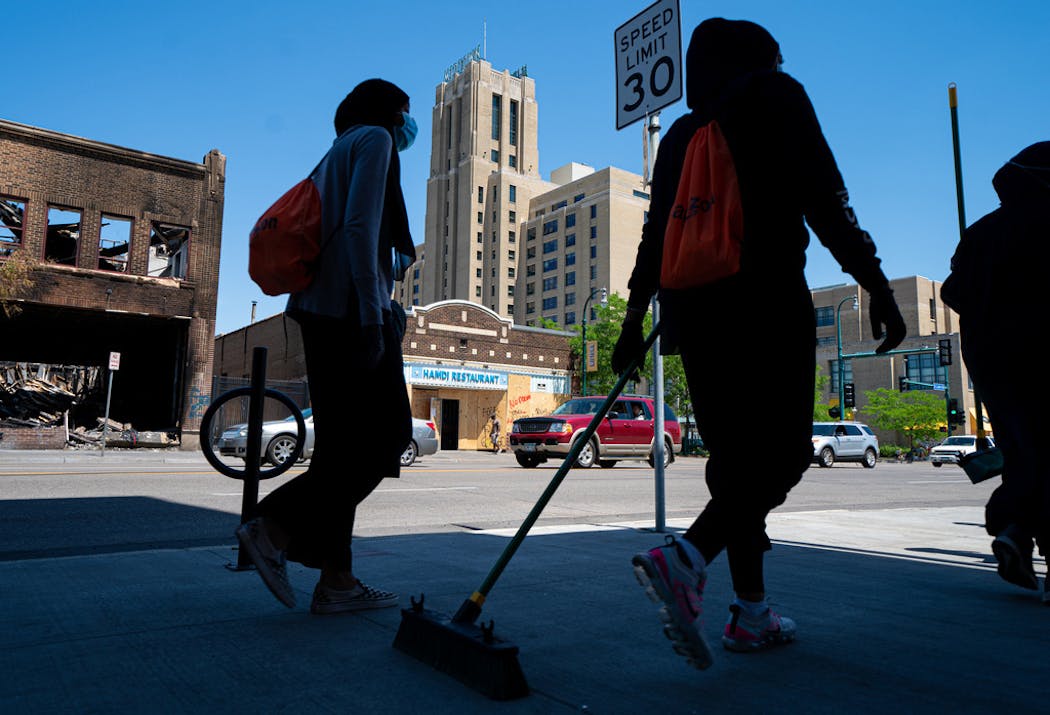The COVID-19 pandemic and the death of George Floyd have brought people out onto the street as never before, showing how much our roadways are no longer just corridors devoted to moving vehicles, bikes and pedestrians as fast and efficiently as possible.
Streets have become the places where we increasingly pursue our personal, public and even our political lives, and we could use some new ways of talking about them. We also could use new names for them that more accurately describe how we have come to use them.
Here are a few suggestions from an urban design perspective:
As an honoring space
The intersection of S. Chicago Avenue and 38th Street in Minneapolis has become a safe space for diverse communities to come together to honor the place where the Floyd tragedy unfolded at the hands of police. It will likely become a place of pilgrimage for those who want to see where the international movement for police reform all began, where the death heard 'round the world occurred.
We need to see that intersection as a sacred space and a people-friendly place that either prohibits vehicles or at least has design features — like pavers, planters and speed bumps — that slow traffic to a respectful crawl. It also should retain its community character and continue to accommodate the street art, impromptu memorials and difficult conversations.
As First Amendment space
A different but equally important use of a street happens in front of the Minnesota governor's residence on Summit Avenue in St. Paul. During the pandemic and now, in the wake of Floyd's death, we have seen thousands of people gather in and along that street, sometimes blocking traffic or using vehicles to send a political message.
That section of street will likely continue to be a place where people engage in their First Amendment right to free speech and to peaceably assemble. We should recognize the special nature of that place. We should also put in place traffic-calming measures and more provisions for those expressing their political opinions, like wider sidewalks, accessible seating and more shade.
As a 'commoning' space
While few streets have such distinctive roles to play in our public life, every street has the possibility of becoming more than just a pass-through.
As Minnesota's Jay Walljasper has written, we are gradually moving toward a "commons-based society," where "the competition that characterizes life today would be balanced with new attitudes and social structures that foster cooperation."
We've already seen streets of all kinds begin to play that commons role. Some parkways already have been closed to vehicles to give pedestrians more space to social distance, curbs along protest routes have become places to hand out water and snacks, and sidewalks along Lake Street in Minneapolis and University Avenue in St. Paul have become spaces where volunteers have worked with the cities and business owners to clean up after the riots.
We might find ways to honor such "commoning" places, perhaps with plaques that tell the story of what happened here and recognize volunteer participants.
As a shared space
As we have been outdoors more — whether for political or pandemic reasons — we face the challenge of sharing public space, while social distancing. Many people have risen to the challenge, increasingly using streets that have few cars these days as places to walk and jog, particularly in more congested parts of the cities and suburbs where remaining 6 feet apart has become a problem.
This has turned some side streets into shared streets, where people, and often their pets, perambulate along pavement where cars once had sole prerogative. And we might use streets for more than just walking. The Dutch have woonerfs, or "living streets," that are curb-less streets that pedestrians and cars share that can also accommodate play spaces for children and dining spaces for friends and neighbors.
We all share in funding the maintenance and repair of our streets through our tax dollars. But the pandemic and the protests have shown how streets might play many more roles than what they have in the past. Imagining what those uses might be is something we also can share in.
We map what we care about, and maybe the time has come to design new kinds of maps of our streets. Such maps would show not only the names and locations of roadways, but also what meaning different streets have for different people, what communities these streets accommodate, what events they embody, and what stories they tell.
Such maps might be helpful especially in times like these, when we are all trying to find our way.
Thomas Fisher is the director of the Minnesota Design Center at the University of Minnesota and a professor in its School of Architecture.

Trail section at one of Minnesota's most iconic spots closing for rehab

Will 'shotgun only' zone for deer in southern Minnesota be abolished?

Four Minnesotans catch salmonella in outbreak linked to basil sold at Trader Joe's




